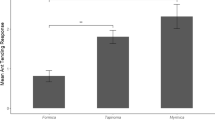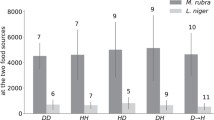Summary
Social organization allows a division of labor between reproduction and foraging, as well as a task allocation among foraging individuals. Therefore, a colony simultaneously exploiting various resources can use different ways of getting them. This work analyzes wood ant foraging tactics both at the collective and the individual level. The main issues are: (1) How does a wood ant colony respond to stable vs temporally and spatially variable resources in terms of worker force allocation? (2) How is retrieval of ephemeral but rich resources effected at the individual level? The results show a correspondence between resource stability and behavior. Ants visited stable resources continually and recruited to ephemeral ones. They also visited empty food sites at a low frequency suggesting territoriality and constant scanning. The results suggest that recruitment may involve defence of the resource, since only a small fraction of all the workers available carry the food home. Additional ants arriving at the resource are recruited from inside the nest, not by reallocating outdoor workers. The foragers also form two separate groups, one site-persistent and another site-flexible. These two forager groups may reflect specialization on two different kinds of diet: honeydew or insect prey (spatially and temporally stable vs unstable resources, respectively).Formica truncorum is thus an example of how sociality allows the use of two different foraging strategies simultaneously: one that is based on recruitment to ephemeral resources and another that is based on search persistance and memory.
Similar content being viewed by others
References
Ayre, G. L., 1960. Der Einfluss von Insektennahrung auf das Wachstum von Waldameisen.Naturwissenschaften 47:502–503.
Brian, M. V., 1973. Feeding and growth in the ant Myrmica.J. Anim. Ecol. 42:37–53.
Brian, M. V., 1983.Social insects: Ecology and behavioural biology. Chapman & Hall, London.
Burton, J. L. and N. R. Franks, 1985. The foraging ecology of the army antEciton rapax: an ergonomic enigma?Ecol. Entomol. 10:131–141.
Calabi, P., 1987. Behavioural flexibility in Hymenoptera: a reexamination of the concept of caste. In:Advances of myrmecology (J. C. Trager, Ed.). E. J. Brill, New York, pp. 237–259.
Calabi, P., J. F. A. Traniello and M. H. Werner, 1983. Age polyethism: its occurrence in the antPheidole hortensis, and some general considerations. — Psyche 88:231–244.
Carroll, C. R. and D. H. Janzen, 1973. Ecology of foraging by ants.Ann. Rev. Ecol. Syst. 4:231–257.
Cosens, D. and N. Toussaint, 1985. An experimental study of the foraging strategy of the red wood antFormica aquilonia.Anim. Behav. 33:541–552.
Cosens, D. and N. Toussaint, 1986. The dynamic nature of the activities of the wood antFormica aquilonia foraging to static food resources within a laboratory habitat.Physiol. Entomol. 11:383–395.
Dobrzanska, J., 1958. Partitioning of foraging grounds and modes of conveying information among ants.Acta Biol. Exp. 18:55–67.
Fewell, J. H., 1990. Directional fidelity as a foraging constraint in the western harvester ant,Pogonomyrmex occidentalis.Oecologia 82:45–51.
Franks, N. R., 1985. Reproduction, foraging efficiency, and worker polymorphism in army ants. In:Exp. Behavioural Ecology and Sociobiology. (Hölldobler, B. and M. Lindauer, Eds.), Fisher, Stuttgart, pp. 81–108.
Fresneau, D., 1985. Individual foraging and path fidelity in a Ponerine ant.Ins. Soc. 32:109–116.
Gordon, D. M., 1984. The persistence of role in exterior workers of the harvester antPogonomyrmex badius.Psyche 90 (3–4):251–265.
Gordon, D. M., 1989. Dynamics of task switching in harvester ants.Anim. Behav. 38:194–204.
Gordon, D. M., R. Rosengren and L. Sundström, 1992. The allocation of foragers in red wood ants.Ecol. Entomology 17:114–120.
Herbers, J. M., 1976. Behavioural constancy inFormica obscuripes (Hymenoptera: Formicidae).Ann. Ent. Soc. Am. 70:485–486.
Hölldobler, B., 1976. Recruitment behaviour, home range orientation and territoriality in harvester ants Pogonomyrmex.Behav. Ecol. Sociobiol. 1:3–44.
Hölldobler, B. and M. Möglich, 1980. The foraging system ofPheidole militicida (Hymenoptera: Formicidae).Ins. Soc. 27:237–264.
Horstmann, K., 1975. Freilandsuntersuchungen zum Rekrutierungsverhalten bei der WaldameiseFormica polyctena Foerster.Waldhygiene 11:33–40.
Horstmann, K., 1976. Über die Duftspur-orientierung bei Waldameisen (Formica polyctena Foerster).Waldhygiene 15:225–232.
Horstmann, K. and H. J. Geisweid, 1978. Untersuchungen zu Verhalten und Arbeitsteilung von Waldameisen an Rindenlauskolonien.Waldhygiene 12:157–168.
Horstmann, K., A. Bitter and P. Ulsamer, 1982. Nahrungsalarm bei Waldameisen (Formica polyctena Foerster).Ins. Soc. 29:44–46.
Hunt, J. H., 1983. Foraging and morphology in ants: the role of vertebrate predators as agents of natural selection. In:Social insects in the tropics (Jaisson P., Ed.), pp. 88–104.
Kirchner, W., 1964. Jahreszyclische Untersuchungen zur Reservestoffspeicherung and Überlebungsfähigkeit adulter Waldameisenarbeiterinnen.Zool. Jahrb., Physiol. 70:1–72.
Kneitz, G., 1964. Untersuchungen zum Aufbau und zur Erhaltung des Nestwärmehaushaltes beiFormica polyctena Foerst. (Hym.: Formicidae). Dissertation. Univ. of Würzburg, Würzburg Germany.
Lenoir, A., 1987. Factors determining polyethism in social insects. — In:From individual to collective behaviour in social insects (Pasteels, J. M. and J. L. Deneubourg, Eds.), Birkhäuser, Basel, pp. 219–240.
Mirenda, J. T., D. G. Eakins, K. Gravelle and H. Topoff, 1980. Predatory behaviour and prey selection by army ants in a desert-grassland habitat.Behav. Ecol. Sociobiol. 7:129–135.
Oster, G. and E. O. Wilson, 1978.Caste and ecology in the social insects. Princeton Univ. Press, Princeton NJ.
Otto, D., 1958. Über die Arbeitsteilung im Staate vonFormica rufa rufopratensis minor (Gössw.).Wiss. Handl. Dtsch. Akad. Landwirtschaft wiss. Berlin 30:1–69.
Pamilo, P., 1982. Multiple mating in Formica ants.Hereditas 97:37–45.
Porter, S. D. and C. D. Jörgensen, 1981. Foragers of the antsPogonomyrmex owyheei; a disposable caste?Behav. Ecol. Sociobiol. 9:247–256.
Rissing, S. W., 1981. Foraging specializations of individual seed-harvester ants.Behav. Ecol. Sociobiol. 9:149–152.
Rockwood, L. and S. P. Hubbell, 1987. Host-plant selection, diet diversity and optimal foraging in a tropical leafcutting ant.Oecologia 74:55–61.
Rosengren, R., 1971. Route fidelity, visual memory and recruitment behaviour in foraging wood ants of the genus Formica (Hymenoptera: Formicidae).Acta Zool. Fenn. 133:1–150.
Rosengren, R., 1977. Foraging strategy of wood ants (Formica rufa group) I. Age polyethism and topographic traditions.Acta Zool. Fenn 149:1–30.
Rosengren, R. and W. Fortelius, 1986a. Ortstreue in foraging ants of theFormica rufa group — a hierarchy of orienting cues and long-term memory.Ins. Soc. 33(3):306–337.
Rosengren, R. and W. Fortelius, 1986b. Light: dark-induced activity rhythms in Formica ants (Hymenoptera: Formicidae).Entomol. Gener. 11 (3/4):221–228.
Rosengren, R. and W. Fortelius, 1987. Trail communication and directional recruitment to food in red wood ants (Formica).Ann. Zool. Fennici 24:137–146.
Rosengren, R. and L. Sundström, 1987. The foraging system of a red wood ant colony (Formica s.str.) — collecting and defending food through an extended phenotype. In:From individual to collective behaviour in social insects (Pasteels, J. M. and J. L. Deneubourg, Eds.), Birkhäuser, Basel, pp. 117–139.
Sudd, J. H., 1987. Individual behaviour and mixed diet strategy in ants. In:From individual to collective behaviour in social insects (Pasteels, J. M. and J. L. Deneubourg, Eds.), Birkhäuser, Basel, pp. 81–92.
Sudd, J. H. and M. E. Sudd, 1985. Seasonal change in the response of wood ants (Formica lugubris) to sucrose baits.Ecol. Entomol. 10:89–97.
Sundström, L., 1987. Size allocation and task preference in red wood ants. In:Chemistry and biology of social insects (Eder, J. and H. Remboldt, Eds.), Peperny, München.
Taylor, F., 1978. Foraging behaviour of ants: theoretical considerations.J. Theor. Biol. 71:541–565.
Traniello, J. F. A., 1987. Individual and social modification of behaviour in response to environmental factors in ants. In:From individual to collective behaviour in social insects (Pasteels, J. M. and J. L. Deneubourg, Eds.), Birkhäuser, Basel, pp. 63–80.
Traniello, J. F. A., 1988. Variation in foraging behaviour among workers of the antFormica schaufussi: ecological correlates of search behaviour and the modification of search pattern. In:Interindividual behavioural variability in social insects (R. L. Jeanne, Ed.), Boulder, Colo: Westview, pp. 91–112.
Traniello, J. F. A., 1989. Foraging strategies of ants.Ann. Rev. Entomol. 34:191–210.
Wehner, R., P. Schmid-Hempel and R. D. Harkness, 1983.Foraging strategies in individually searching ants Cataglyphis bicolor. Fisher, Stuttgart.
Wilson, E. O., 1971.The insect societies. Harvard Univ. Press, Cambridge, 548 pp.
Ökland, F., 1931. Studien über die Arbeitsteilung und die Teilung des Arbeitsgebietes der roten Waldameise (Formica rufa L.).Z. Morph. Ökol. Tiere 20:63–131.
Zar, J. H., 1984.Biostatistical Analysis. Prentice Hall Inc. N.J., 717 pp.
Author information
Authors and Affiliations
Rights and permissions
About this article
Cite this article
Sundström, L. Foraging responses ofFormica truncorum (Hymenoptera; Formicidae); exploiting stable vs spatially and temporally variable resources. Ins. Soc 40, 147–161 (1993). https://doi.org/10.1007/BF01240703
Received:
Revised:
Accepted:
Issue Date:
DOI: https://doi.org/10.1007/BF01240703




